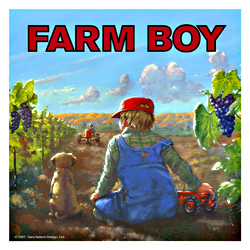Downey’s back! His new monthly column will pry into the local wine game—what’s in, who’s off, and how it goes down.
A few years ago, David LeClaire was already well known in the local wine world, as much for his notorious home hot-tub parties as for his expertise as sommelier for the Alexis Hotel. It’s been a long time since I received an invitation to a co-ed soak at David’s—no swimsuit necessary—but he still throws a great, if more decorous, party.
David, in fact, is in the party business, putting together wine tastings for private homes, charity fund-raisers, and industry functions that entertain while they educate. But one periodic LeClaire event is not just fun and instructive but intrinsically important: his annual Northwest Boutique Winery Showcase, which LeClaire organized for the fifth time Feb. 21 in the banquet rooms of the Lakeside.
Despite its flossy title, the event is serious business. LeClaire limits participation to wineries that have been in production five years or less and who make fewer than 5,000 cases of wine annually. When your operation’s that small, spending a whole day pouring samples for a few hundred people—and sharing the cost of renting the facility—is a substantial commitment of resources. On the other hand, when you’re that small, chances are you still lack a commercial distributor and are selling only through your winery or delivering to wine shops out of the trunk of your car. The chance to show your wares to trade buyers, the press, and curious connoisseurs may be the best investment you can make.
But only if your product is good. Very, very good. At last count, there were more than 450 licensed wineries in the state of Washington, most of them producing four or more wines. Despite worries about market saturation, the number of new operations founded annually is growing instead of slowing. Twenty-nine wineries poured at LeClaire’s showcase. I’d tasted wines from four of them before and heard of another three. The remaining 22 were wholly new to me—and not just to me, a nonprofessional taster, but to most of the trade buyers as well.
A group show like this isn’t assured of success every time out. Last year’s event turned up more misses than hits: overly alcoholic, overextracted reds and wimpy whites with off aromas. But what else would you expect when sampling beginners’ work? The mind-blowing thing about this year’s event was the high quality of the winemaking. I didn’t try everything on offer; even when I’m good about swirling and spitting, sampling 75 wines would put me out for the rest of the day. But I did visit 16 stations, trying nearly 40 wines in the process. Every damn one of them was good.
Not only that: If you didn’t know or didn’t ask, you’d never have realized who the relative old-timers were and who were the new kids on the block. It’s no surprise when John Bell fields half a dozen knockout reds from his 2003 Willis Hall collection; Bell is a master winemaker who’s mentored a whole generation of Washington producers. What’s hard to believe is that the six-wine lineup from Dave and Cindy Lawson’s Covington Cellars are the first fruits of the California couple’s Washington career. I sampled a savory viognier with none of the flabbiness often noticeable in this difficult grape; a bright, singing sangiovese; and a 100 percent cabernet franc that celebrates the wild fragrance and flavor of the fruit with no vegetal aftertaste.
New Washington winemakers continue to come from diverse backgrounds. The Lawsons are both veterans of the business end of the wine industry who attended the world-famous enology program at the University of California, Davis. Robert Smasne is a fourth-generation fruit farmer who proudly exhibits his roots on every bottle of his Farm Boy label. Lake Chelan’s Larry Lehmbecker is the latest “hobbyist” winemaker to ride into town and cart off as many gold medals as he can carry for his Vin du Lac label. Longtime vineyard and winery manager Phil Cline, of Naches Heights Vineyard, is pioneering a high-altitude site up the Naches River within spitting distance of Mount Rainier. His first bottlings—lean, racy 2005 rieslings and pinots gris vinified by Mark Wysling—promise great things. Oregon’s Jim MacCallum (MacCallum Family Cellars) isn’t content to make high-end pinot noirs from his 30-year-old vines; he’s challenging the locals with syrahs and malbecs crafted from Washington fruit.
You won’t yet find most of these wines on retail shelves or restaurant lists, but that doesn’t mean you can’t learn more about them—and purchase bottles. This generation of boutique producers are as sophisticated about marketing as they are in the wine studio, and all but one of the wineries offer their wares via the Internet. Check out their Web sites, read their reviews, and above all, taste their wines. (Visit www.seattleweekly.com/food for a directory to the wineries participating in the showcase.) Pessimists may believe that Washington wine is on the cusp of market saturation. But where quality is concerned, the direction continues straight up.








